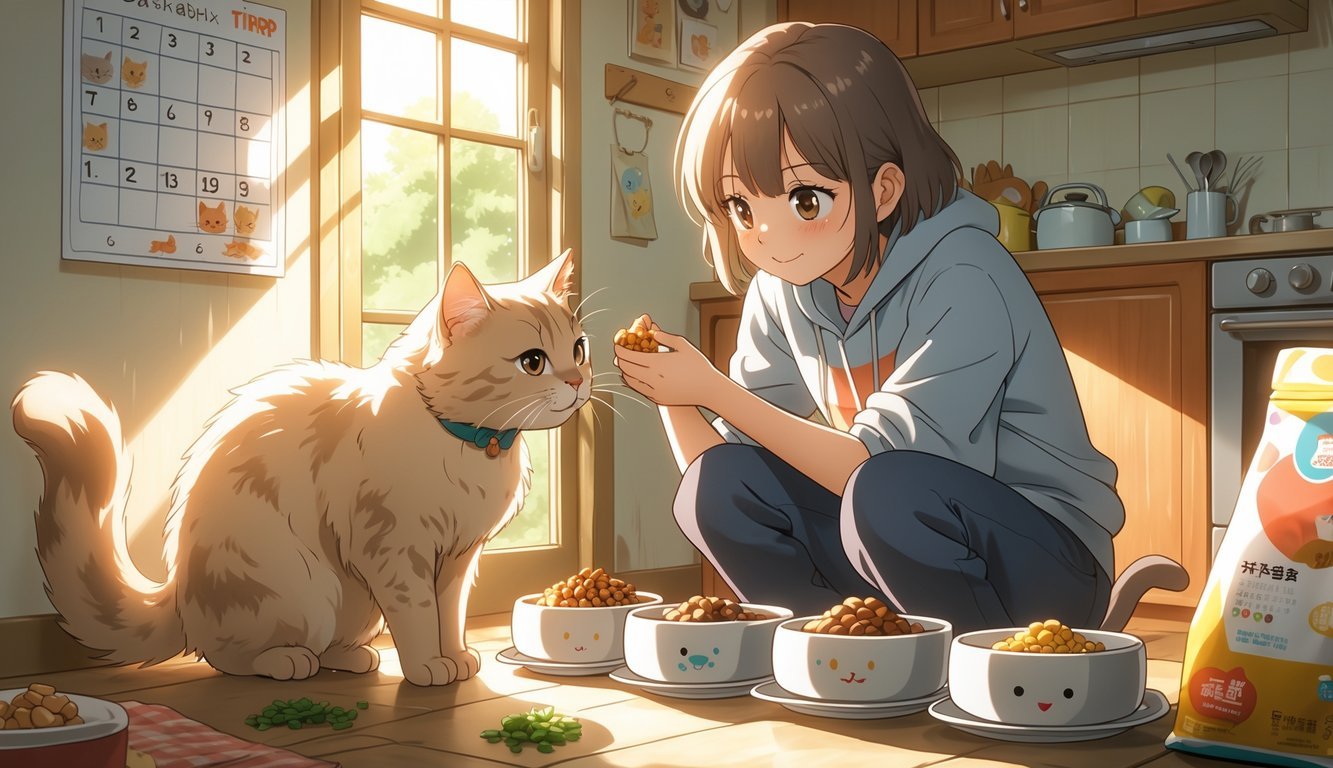PsychNewsDaily Publishers
100 Summit Drive
Burlington, MA, 01803
Telephone: (320) 349-2484
PsychNewsDaily Publishers
100 Summit Drive
Burlington, MA, 01803
Telephone: (320) 349-2484
Switching cat food requires gradual introduction to avoid digestive upset, monitoring behavior and stool consistency, and maintaining hydration to ensure a smooth transition.

Switching your cat’s food isn’t always easy, especially if your cat’s stubborn about what they eat. You want them healthy and happy, but no one wants a grumpy cat or a mess to clean up.
The good news? You can actually make the switch without too much drama if you follow a few simple steps.
You’ll see how to introduce new food in a way that keeps stress low and mealtimes pleasant. Mixing small portions and watching for any tummy troubles helps you guide your cat through the change with less fuss.
If you take it slow and pay attention to your cat’s cues, you can avoid turning dinner into a battleground.

When you start changing your cat’s food, go slow. Mix just a bit of the new food into what your cat already likes.
This lets your cat get used to the new smell and taste without feeling overwhelmed.
Keep the ratio mostly old food at first. Maybe just a spoonful of new food in the usual meal is enough.
This gentle approach means your cat’s less likely to get an upset stomach.
After a few days, bump up the new food a little and cut back on the old. Watch your cat’s reaction.
If your cat turns up their nose or seems uncomfortable, take it back a notch.
Small portions help your cat build trust in the new food. Cats can be suspicious of changes, so patience really pays off.

Start by mixing just a little new food into your cat’s regular meal. That way, your cat gets used to the new taste and smell without too much fuss.
Over several days, slowly increase the new food and decrease the old. Many people use a schedule: 25% new after a couple days, then 50%, then 75%, and finally all new food.
Most cats adjust in about 7 to 10 days, but some need extra time. If your cat seems upset or refuses to eat, slow things down and give them a break.
Keep an eye on your cat’s appetite and litter box during the switch. That way, you can catch any problems early and make changes if needed.

As you mix in the new food, watch how your cat acts. Notice changes in appetite, energy, or behavior.
A little change is normal, but big shifts might mean the new food isn’t working.
Check the litter box every day for stool consistency. Firm, well-formed poop usually means things are going well.
If you see loose stools, diarrhea, or constipation, you might be moving too fast.
If your cat vomits or seems really uncomfortable, pause the switch and go back to the old food for a bit.
Once your cat feels better, try again, but even slower.
Every cat’s different, so patience is key.
By watching your cat’s reaction and stool, you can make sure the change goes smoothly.

Serve the new food during your cat’s usual feeding times. Cats love routine, so sticking to the same schedule helps them feel secure.
Start with a little new food mixed in at the normal times. This way, your cat connects the new taste to their regular meals.
If your cat doesn’t finish, take the bowl away after 20–30 minutes. Offering food for a set time teaches your cat to eat when food’s out, not to snack all day.
You can also give a tiny bit of new food as a treat. That makes the new food seem like something special.
Stay consistent and patient. Serving the new food at the same times every day really helps your cat adjust.

If you swap your cat’s food all at once, you’ll probably deal with upset stomachs. Cats can get vomiting, diarrhea, or just stop eating.
Their digestive systems need time to get used to new stuff.
Instead of dumping the old food, mix in the new food gradually. Start small and keep most of the old food in the bowl.
This gives your cat’s body time to handle the different ingredients.
A slow switch also helps picky cats accept the new taste and texture. Mixing the two makes things less stressful for everyone.
Most vets recommend taking about 7 to 10 days for the change. If your cat’s stomach is sensitive, you can go even slower.
Moving gradually lowers the risk of tummy troubles and makes the whole process easier.

If your cat turns up their nose at new food, try mixing in a bit of wet food with the dry. Wet food smells stronger and feels softer, which can tempt a picky eater.
Start with just a little so your cat doesn’t get overwhelmed.
Gradually increase the wet food over time. This slow change helps your cat accept it without skipping meals.
A lot of cats like the combo of crunchy and moist textures.
If your cat still isn’t interested, try warming the wet food just a bit before mixing. The extra aroma might spark curiosity.
Always check the food isn’t too hot—just a little warm is enough.
Mixing wet and dry gives your cat variety and can make the transition smoother.
This trick works well for cats who ignore plain wet food.

When you change your cat’s food, always make sure there’s clean water nearby. New foods, especially dry kibble, can make your cat extra thirsty.
Having water ready keeps your cat comfortable during the switch.
Wash your cat’s water bowl or fountain every day with mild soap and rinse it well.
Cats might avoid drinking if the water tastes funny or the bowl smells off.
Put water bowls in quiet spots around the house. Some cats like to drink away from their food, so try different places.
More options mean your cat can drink whenever they want.
If your cat doesn’t drink much, consider a pet fountain. Many cats love running water.
Adding wet food can also help keep your cat hydrated.
Keeping fresh water available supports digestion and helps your cat handle the new food with less stress.

If your cat has a medical condition, talk to your vet before changing food. Health problems like kidney disease, diabetes, or allergies often need special diets.
Switching foods without advice can make things worse.
Your vet can help you pick food that fits your cat’s needs. They might suggest prescription diets or tell you what ingredients to avoid.
That way, the transition is safer and more comfortable for your cat.
Even if your cat seems fine, a quick vet check can give you peace of mind.
Your vet might notice something you missed or just reassure you that you’re on the right track.
If your cat takes medication, ask your vet if the new food will interfere.
It’s better to be safe and keep your cat’s treatment working as it should.
By involving your vet, you make sure the change fits your cat’s health needs.
It’s a simple step that can save you—and your cat—a lot of trouble.

Your cat’s health depends on food that supports their digestion, energy, and comfort. If you watch how they react to meals and change things slowly, you’ll avoid stomach upsets and mealtime drama.
Cats sometimes get sensitive to certain ingredients, which can make them uncomfortable or act differently. You might see vomiting, diarrhea, or more hairballs after meals.
Other signs include itchy skin, ear infections, or too much grooming.
If your cat suddenly avoids their food, it might be a taste issue or the food just doesn’t feel right.
Jotting down these reactions in a notebook can help you spot patterns.
Common triggers are:
Not every symptom means a food allergy, but if you see problems often, ask your vet.
A vet can suggest an elimination diet or a formula for sensitive tummies.
Switching food too fast can upset your cat’s digestion. Their stomach and gut bacteria need time to get used to new ingredients.
A slow switch also helps picky eaters adjust.
A typical 7–10 day plan looks like this:
Some cats need even more time, especially if they’re older or have sensitive stomachs.
Watch for loose stools, vomiting, or not eating, and slow down if you need to.
Patience really does make the change easier and keeps your cat happy.

Your cat might need some extra patience and reassurance while they get used to new food.
Pay attention to their comfort at mealtime and watch their health to make the switch go smoothly.
Cats aren’t fans of change, so a calm setting helps them try new food. Feed your cat in a quiet spot away from noise, other pets, or distractions.
Keeping the same time and place every day helps them feel safe.
Mix the new food with the old in small amounts. Gradually increase the new food over about a week.
This slow change lowers the chance of an upset stomach and helps your cat accept the new taste.
You can also make meals more inviting by:
Always praise your cat for eating, but don’t force it.
Gentle encouragement works way better than pressure.
While you’re switching foods, keep an eye on your cat’s body language. Pay attention to how they’re using the litter box too. Small changes can happen, but if your cat keeps vomiting, has diarrhea that won’t stop, or just won’t eat, that’s a red flag.
Weigh your cat every week. If you see a sudden drop, they probably aren’t eating enough. Take a look at their coat as well. If it looks dull or you notice more shedding than usual, maybe the new food isn’t working out.
Try using a simple checklist to keep track:
| What to Watch | Normal | Concerning |
|---|---|---|
| Appetite | Slight change | Refuses food >24 hrs |
| Stool | Firm, small changes | Diarrhea >2 days |
| Energy | Normal play | Lethargy |
If you spot any ongoing problems, reach out to your vet before you keep feeding the new food.